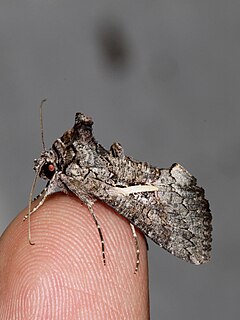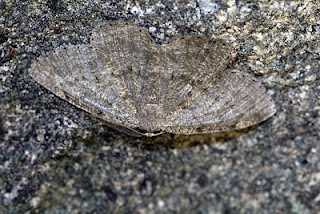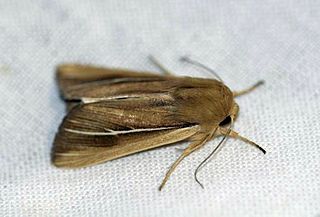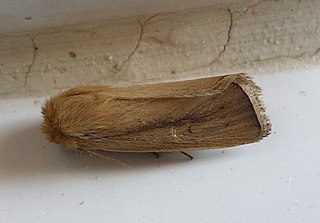 W
WAgrochola haematidea is a moth of the family Noctuidae. It is found in the Southern parts of Europe.
 W
WApterona helicoidella is a moth of the Psychidae family. It is widely distributed in Europe, from Portugal through most of central Europe and the Alps, up to the Ural. It is also found on the Balkan and in Turkey. It was introduced in the United States by accident during the 1940s. It is now found in many mid-Atlantic states, including Pennsylvania, and has also been reported in the Pacific coastal states, as well as Colorado, Michigan, Nevada, Utah and Idaho. It has been collected in Ontario as well.
 W
WCallopistria latreillei, Latreille's Latin, is a moth of the family Noctuidae. The species can be found in the Palearctic realm, most parts of Europe, Asia, and in Africa from Egypt to South Africa. The habitat consists of rocky limestone slopes with deciduous woodland.
 W
WCtenoplusia accentifera is a moth of the family Noctuidae. It is found in South-Western Europe, Greece, Africa, the Near East and Asia Minor.
 W
WDinia mena is a moth of the family Erebidae. It was described by Jacob Hübner in 1827.
 W
WDrasteria cailino is a moth of the family Erebidae first described by Alexandre Louis Lefèbvre de Cérisy in 1827. It is found in southern Europe, the Near East and Middle East up to the western Himalayas in the east. In the Levant, several isolated populations are present in Lebanon, Syria and Israel.
 W
WErebus ephesperis is a moth of the family Erebidae first described by Jacob Hübner in 1827. It is found in Asia, including India, Japan, the Korean Peninsula, China, Singapore and Borneo.
 W
WEudonia angustea is a moth of the family Crambidae described by John Curtis in 1827. It is found in southern and western Europe, the Canary Islands, Madeira and Turkey.
 W
WEudonia lineola is a species of moth in the family Crambidae. It is found in Great Britain, Ireland, the Netherlands, France, Spain, Portugal and on Sardinia, the Canary Islands, as well as in North Africa, including Morocco.
 W
WEudonia murana, the Scotch gray or wall grey, is a moth of the family Crambidae. It was described by John Curtis in 1827 and is found in most of Europe.
 W
WEudonia pallida is a species of moth of the family Crambidae. It was described by John Curtis in 1827 and is known from most of Europe.
 W
WGnophos dumetata, the Irish annulet, is a species of moth in the family Geometridae. It is found in large parts of Europe, except Great Britain, Portugal, the Benelux, Switzerland, Bulgaria, Fennoscandia and the Baltic region. It is also found from north-western Africa to Armenia, Dagestan, and the south-western part of the former Soviet Union.
 W
WHyles dahlii is a moth of the family Sphingidae first described by Carl Geyer in 1828.
 W
WLeucania loreyi, the cosmopolitan, false army worm or nightfeeding rice armyworm, is a species of moth of the family Noctuidae. It is found in most of African countries, the Indo-Australian subtropics and tropics of India, Sri Lanka, Myanmar, the eastern Palearctic realm, and the Near East and Middle East. The species was first described by Philogène Auguste Joseph Duponchel in 1827.
 W
WMetastatia pyrrhorhoea is a moth of the subfamily Arctiinae. It was described by Jacob Hübner in 1818. It is found in Guyana and Brazil (Pará), Costa Rica and Panama.
 W
WMythimna litoralis, the shore wainscot, is a moth of the family Noctuidae.
 W
WOiketicus kirbyi is a moth of the family Psychidae. It is found in lowlands from Argentina to Mexico and on the Caribbean islands.
 W
WPachypasa limosa is a moth of the family Lasiocampidae. It is found in southern France, the Iberian Peninsula and North Africa.
 W
WSesamia nonagrioides, the Mediterranean corn borer, pink stalk borer or West African pink borer, is a moth of the family Noctuidae. It was described by Alexandre Louis Lefèbvre de Cérisy in 1827. It is found in Spain, southern France, Italy and on the Balkan Peninsula, as well as in north-western, south-western and western Africa.
 W
WStreblote siva, the jujube lappet moth, is a medium-sized moth, a widespread Arabic species. It has been documented in the UAE, Bahrain, and Qatar. The species was introduced to Iran. It belongs to the family Lasiocampidae. The species was first described by Lefèbvre in 1827.. The species primarily consumes plants of the genus Ziziphus as well as Acacias.
 W
WVirbia rubicundaria, the ruddy holomelina, black-banded holomelina or least holomelina, is a moth in the family Erebidae. It is found from Georgia and Florida, along the Gulf Coast to eastern Texas.
 W
WWheeleria spilodactylus is a moth of the family Pterophoridae, first described by John Curtis in 1827. It is found in South-Western and Central Europe and the Mediterranean, Asia Minor and North Africa. It has been introduced to Australia as a biocontrol agent for white horehound.